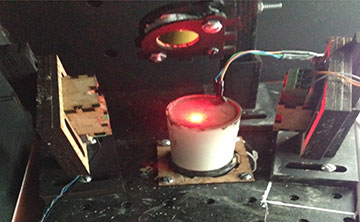
For real-time characterization of cement setting, Mexican researchers combined diffuse reflection measurements with an optical model. [Image: José Ortiz-Lozano, Universidad Autónoma de Aguascalientes]
As the binding component in concrete and mortar, cement is the world’s most frequently used material. Despite its ubiquity, however, scientists still have difficulty measuring the setting or hardening time of this complex substance without penetrating the material, introducing uncertainty from human factors or even destroying part of the paste as it sets.
Researchers from three Mexican laboratories have now developed a non-invasive, optical technique for measuring the setting rate of the most common type of cement (Appl. Opt., doi: 10.1364/AO.59.0000D1). The method, which combines reflections of laser light with mathematical modeling, could help the construction industry as well as scientists trying to lessen cement’s impact on the environment.
Cement: Ancient and ubiquitous
The earliest forms of cement date back to the ancient Greeks and Romans, but the most common form of cement in use today, Portland cement, was developed in the first half of the 19th century. Today, Portland cement is delivered to construction sites as a finely powdered mixture of multiple compounds of calcium and silicon, and the addition of water triggers four stages of chemical reactions, some of which are exothermic.
Civil engineering professor José A. Ortiz-Lozano of the Universidad Autónoma de Aguascalientes, Mexico, and his colleagues realized that the Kubelka-Munk theory, which describes diffuse reflectance from opaque materials via the ratio of their scattering and absorption coefficients, would apply to freshly mixed cement.
Optical observations
The team set up a 5-mW He-Ne laser with a beam splitter to direct the red light onto the surfaces of six freshly hydrated samples of cement. Optical detectors measured the scattered and reflected light as the cement samples went through the four stages of hydration and setting. The researchers used Kubelka-Munk modeling to calculate the length of time the cement spent in each stage of the setting process, which took about nine hours in all. The stages, as calculated by the model based on optical observations, correlated well with direct measurements taken by an intrusive needle-penetration test.
Since the laser setup measures the cement properties continuously, as opposed to discrete measurements from the needle-penetration test, the scientists say that their proposed technique could yield new insights into the physical and chemical properties of cement. Knowing more about the behavior of cement—the manufacturing of which leads to large releases of carbon dioxide into the atmosphere—could also aid in the search for less toxic replacement binding materials.
Researchers from the Centro de Investigaciones en Óptica and TechNM/Instituto Tecnológico de Aguascalientes, both in Mexico, also contributed to the study.
